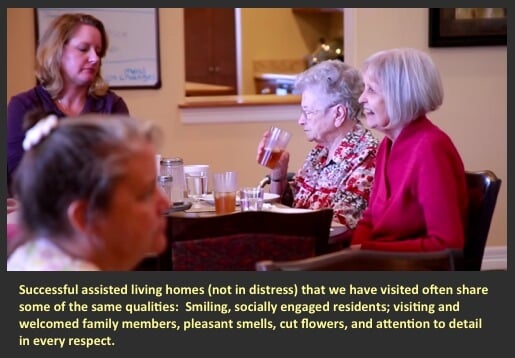Identifying and Avoiding Distressed Assisted Living Homes
Suwanee, Georgia – DISCOVERY VILLAGE AT SUGARLOAF IN SUWANEE

Summary: An assisted living home is ‘distressed’ if it is struggling to retain, or get residents, or if it is having trouble financially or with state inspections. Learn how to identify a distressed assisted living facility and how, and if you should avoid placing an elderly family member into one.
Ive had a lot of opportunities to learn about the assisted living industry in the past 10 years or so, simply by being invited on numerous occasions to assisted living homes and facilities.
The purpose of each invitation varied, but most often, it was either to do an interview, or to film the residence for a video tour, or to take photos (see some our facility photography).
Assisted Living Homes are never apples to apples. Although they are required by their state to adhere to a certain set of rules, regulations and standards, no two homes are alike. Two of the obvious ways they differ:
Facility Size: Larger facilities can reach upwards of 200 residents, and smaller facilities can be as cozy as 4 (learn more about facility size).
Financial backing: Larger facilities may be corporate entities, with capital streams coming from investors, investments, donations, and of course, revenues generated from business operations.

Smaller facilities, however, are often self-funded, or have little in the way of reserves or outside help (investors). Their marketing reach is more limited, and the impact of an empty bed is significant – not as easily absorbed or budgeted for as in most larger facilities.
One residential assisted living home I visited recently was being funded by a married, retired couple’s personal retirement savings, which was slowly being depleted. Their life-savings being obliterated by a 6-bed care home with only one resident.
This facility was fairly new, and was opened in an already saturated market.
The one resident created it’s own set of problems. When potential residents and families would ask to tour the facility, the many empty beds would not give off the best impression of a business that was thriving.
The single, female resident, suffering from dementia, looked tired, socially unstimulated, and lonely.
Families want to see, and envision a facility with happy seniors, participating in activities, being cared for by qualified, compassionate staff. Families expect to have a positive sensory experience, with the smell of baked cookies in the air, fresh flowers on the table, spotless, well kept rooms and common areas, and enthusiastic, knowledgeable and hands-on owners and administrators.
When a family shows up for a tour and is greeted to a cold-feeling, empty, stale, lifeless ghost-town of a facility, theyll likely turn elsewhere, adding to the layers of growing problems that can snowball into possible, eventual closure of the facility, and a mountain of debt – not to mention the strain on, and possible displacement on it’s existing residents. It was a textbook example of a Distressed Facility.
How can anyone really tell if a facility is in distress?
As we touched on earlier, the overall feel, or sensory experience should be a first clue. When you visit a facility for the first time, what does your gut instinct tell you? Are the residents happy, and more so, are the staff and owners smiling and helpful?
As you drive up, is the facility well kept, or are there weeds in the driveway cracks, and are there shingles hanging off the roof?
What is the staffing-to-resident ratio? Most states have a required minimum staff-to-resident ratio. Is the facility or home you are interested in over that, or hanging on with the minimum? Are they breaking the law by having less than the minimum required amount of staff?
facility in distress examplesAre there game boards (such as checkers or puzzles) out and being used by the residents, and is there any sign of structured social, or exercise activities in the home? Do the residents seem engaged in a scheduled movie, or are they sitting around looking tired and apathetic?
A home in distress may cut back on it’s activity calendar or eliminate it altogether.
Many of the well-run and successful facilities Ive visited pay attention to smaller details, like having bowls of fresh apples on the table, or fresh-cut flowers in vases around the house, and nice, old-time or holiday music playing.

Successful homes proudly display their robust menus, activity calendars, transportation schedules, Long-Term Care Ombudsman phone numbers, recent inspections scores and the like.
Successful assisted living homes have an open door policy for family members and most guests. They aren’t attempting to hide ‘what’s under the hood.’
Successful and thriving homes will make you feel good by simply being there – visitor or resident.
Should I trust my mom or dad’s care with a new or distressed assisted living home?
New is one thing, distressed is another. I am all for new businesses achieving success, but more due diligence may be required on the front-end in terms of research of the facility’s owners, the staff’s backgrounds, and the financial backing and buoyancy of the facility. A new facility obviously wont have the reputation and reviews of other residents and families.
A distressed facility (one that is in trouble) is another thing altogether, and unfortunately, these are often newer facilities – but not always.
If an established facility gets a bad review or inspection, compromising it’s reputation, they may lose existing residents or have trouble attracting new ones.
Obviously, a distressed facility is not doing everything right. Perhaps they arent marketing correctly, or they may have failed to have an accurate or realistic business plan from the start.
Indeed, there are many people out there who are born to be caregivers, but who have no skills at running and managing a business. On the flip side, there are plenty of high-aspiring business types out there that lack the compassion and empathy to be in the caregiving business.
It’s rare to find a person (and facility) with both skill sets.
Distressed facilities may scape by for a while, lowering their price until they attract any resident that will pay, regardless of liability (financial burden on the facility). This is often a downward spiral the will lead to the eventual demise of the facility.
If you and your family are fortunate to not be in a desperate situation and can research and shop around, look at reviews, visit facilities (unannounced if possible), and research inspections and citations, then opting for an established facility with solid financial backing and reserves is always preferred.
Taking a gamble on a facility with a rocky past and questionable future will almost certainly more, and ongoing problems and stress.
Buying Time Instead of Making An Emotional Decision
If you are in a desperate situation to place a family member (or yourself) and finances, lack of insurance, a health condition or other circumstance is making it difficult (yet easier to make an emotionally based decision, instead of on facts and research) I recommend that you contact your local area agency on aging (every city, town and rural area in the US are covered by one).
An agency on aging can possibly offer services, programs and support at little or no cost, and can often times buy a family time if they are against a wall with placing an elderly family member who is in failing health or finances.
They can usually offer meal delivery, transportation, check-in and companionship services, small home repairs and errands, and much more.
They can also often times work with families (information and referral) to find appropriate care, and to identify if financial assistance may be available.
To identify your area agency on aging, and to learn more visit Assisted Living Directory’s Agency on Aging page or visit N4A.org
Responses to this article
No comments yet
No Obligation
Assisted Living with Identifying and Avoiding Distressed Assisted Living Homes





